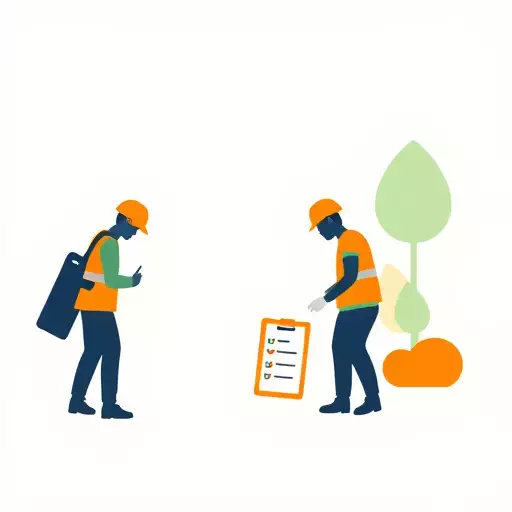Chemical safety training is a cornerstone of comprehensive environmental health and safety (EHS) programming, empowering employees with knowledge and skills to handle hazardous substances safely. Effective EHS training planning involves strategic content design based on workplace risks and regulatory requirements, utilizing compliance training scheduling tools for efficient management. These tools streamline delivery, track progress, and identify learning gaps, fostering a culture of safety through optimized occupational safety training programs. By integrating interactive modules, regular assessments, and continuous improvement, organizations can enhance worker safety, productivity, and compliance with regulatory standards.
In today’s industrial landscape, chemical safety training is paramount to protect workers, comply with regulations, and ensure operational efficiency. This comprehensive guide explores essential elements of designing and delivering effective environmental health and safety (EHS) training programs, focusing on chemical handling. From understanding the importance of tailored occupational safety training to leveraging interactive learning modules and compliance training scheduling tools, this article provides strategic insights for organizations seeking to excel in EHS training planning.
- Understanding the Importance of Chemical Safety Training
- Designing Comprehensive Environmental Health and Safety Training Programs
- Incorporating Occupational Safety Training for Chemical Handling
- Tools for Compliance Training Scheduling and Management
- Creating Interactive Learning Modules for Effective Retention
- Evaluating and Updating Chemical Safety Training Effectiveness
- Best Practices for Delivering In-Person vs. Virtual Training Sessions
Understanding the Importance of Chemical Safety Training

Chemical safety training is an indispensable component of any comprehensive environmental health and safety (EHS) program. It equips employees with the knowledge and skills necessary to work safely around hazardous substances, minimizing the risk of accidents, injuries, and exposure to harmful chemicals. In today’s world, where businesses operate in a highly regulated environment, ensuring compliance with occupational safety training programs is not just a best practice but also a legal requirement.
Effective chemical safety training involves more than just delivering information; it requires structured planning that aligns with the specific needs of the workplace. Compliance training scheduling tools can be invaluable in managing this process, allowing organizations to streamline their efforts and ensure every employee receives up-to-date, relevant instruction. By investing in robust environmental health and safety training planning, companies not only protect their employees but also promote a culture of safety that benefits the entire organization.
Designing Comprehensive Environmental Health and Safety Training Programs

Designing comprehensive environmental health and safety (EHS) training programs is a multifaceted process that requires meticulous planning and strategic implementation. The primary goal is to ensure that all employees, regardless of their role or department, receive uniform instruction on critical safety protocols and regulatory compliance. Effective EHS training planning involves identifying specific risks and hazards inherent in the work environment, aligning these with relevant industry standards and legal requirements, and tailoring content accordingly. This includes topics such as hazard communication, personal protective equipment (PPE), emergency response procedures, and proper waste management.
Leveraging compliance training scheduling tools can significantly streamline this process. These digital platforms offer centralized repositories for safety documentation, easy-to-use interfaces for course curriculum creation, and automated scheduling capabilities that ensure timely delivery of training sessions. By integrating such tools into the EHS training planning process, organizations can maintain consistency, track employee progress, and promptly address any knowledge gaps, thereby fostering a culture of safety and compliance across all departments.
Incorporating Occupational Safety Training for Chemical Handling

Incorporating effective occupational safety training for chemical handling is a cornerstone of any comprehensive environmental health and safety training planning. Organizations must ensure that employees are adequately equipped to manage hazardous substances safely, minimizing exposure risks and preventing accidents. Well-structured occupational safety training programs should cover topics such as proper storage, handling, disposal, and emergency response procedures for common chemicals used in the workplace.
Utilizing compliance training scheduling tools can streamline the process of delivering these essential skills. These digital solutions allow organizations to manage employee attendance, track completion rates, and generate reports on training effectiveness. By integrating such tools into their safety management system, companies can enhance accountability, maintain regulatory compliance, and foster a culture of continuous improvement in occupational safety training for chemical handling.
Tools for Compliance Training Scheduling and Management

Creating Interactive Learning Modules for Effective Retention

In today’s digital era, creating interactive learning modules for chemical safety training can significantly enhance knowledge retention and engagement among employees. These modules should incorporate diverse multimedia elements like videos, animations, and interactive simulations to present complex information in an accessible manner. By providing hands-on experiences through virtual lab scenarios or case studies, trainees can apply their understanding directly, fostering a deeper comprehension of critical safety protocols.
Effective environmental health and safety training planning relies on leveraging compliance training scheduling tools that allow for personalized learning paths and adaptive content delivery. These tools enable organizations to track progress, identify knowledge gaps, and adjust training programs accordingly. Additionally, incorporating regular quizzes, games, or gamified elements within modules can reinforce key concepts, making occupational safety training programs more dynamic and memorable.
Evaluating and Updating Chemical Safety Training Effectiveness

Evaluating the effectiveness of chemical safety training is a vital component of any comprehensive environmental health and safety training planning. It involves assessing whether employees have acquired the necessary knowledge and skills to handle hazardous chemicals safely. Regular assessments, including practical demonstrations and theoretical quizzes, can gauge individual and organizational progress. By analyzing training outcomes, companies can identify gaps in understanding or areas where additional instruction is required. This iterative process ensures that occupational safety training programs remain dynamic and relevant to evolving chemical hazards.
Updating training materials based on new research, regulatory changes, and incident reports is crucial for maintaining compliance with safety standards. Compliance training scheduling tools can automate the process of distributing updates and tracking completion rates, fostering a more responsive and efficient learning environment. Regular reviews and feedback sessions involving employees contribute to continuous improvement, making chemical safety training an ongoing commitment rather than a one-time event.
Best Practices for Delivering In-Person vs. Virtual Training Sessions

When designing chemical safety training, whether in-person or virtual, best practices should guide your approach to maximize engagement and knowledge retention. For environmental health and safety training planning, consider a mix of interactive activities, case studies, and demonstrations. In-person sessions benefit from hands-on exercises where trainees can safely manipulate chemicals under controlled conditions. Virtual platforms excel at delivering detailed multimedia content, allowing for in-depth explanations of chemical properties and potential risks.
Effective compliance training scheduling tools should be utilized to manage both formats. For virtual training, this means setting clear schedules, sending reminders, and ensuring reliable tech support. In-person sessions require careful venue booking, equipment preparation, and logistical planning to accommodate trainees. Regardless of the format, regular assessments and feedback mechanisms are crucial for evaluating comprehension and making improvements to your occupational safety training programs.


